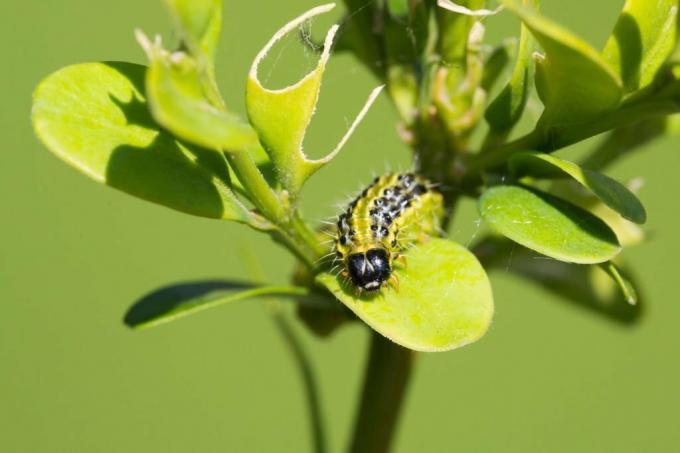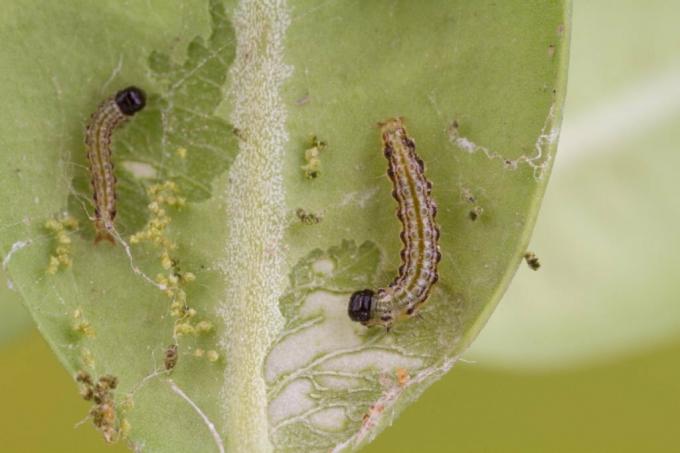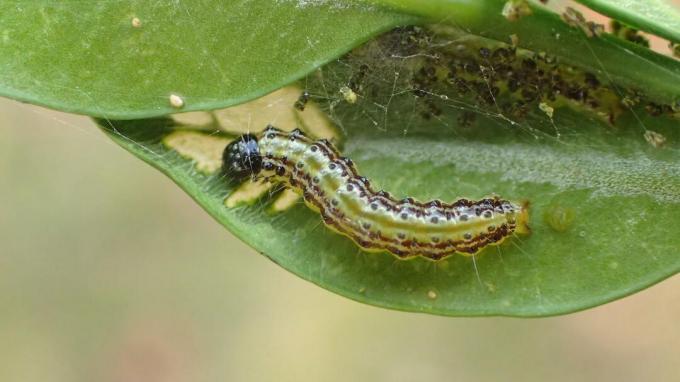If you want to fight boxwood moth caterpillars, you must be able to recognize them with certainty. We provide good pictures, descriptions and information on determination.

The caterpillar of the Box tree moth (Cydalima perspectalis) has a tremendous potential for harm and can damage the loved one Boxwood (Buxus) put an end to it in a very short time by scavenging. The detection of the pest is important in order not to accidentally go to the spray or to others for no reason elaborate methods - or the other way around, the destruction of a beautiful piece of green in the garden to allow.
contents
- What does the boxwood moth caterpillar look like?
- When do you find the boxwood moth caterpillar?
- Boxwood moth caterpillar: way of life
- Moth caterpillar discovered: what to do?
Know your enemy: what does the boxwood moth caterpillar look like? When do you meet them and how do the different larval stages live? We answer these important questions and point out ways to combat the borer caterpillar.
What does the boxwood moth caterpillar look like?
They hatch about three days after the moths lay their eggs Box tree moth eggs small, yellowish-green caterpillars with a deep black head capsule. This conspicuously black head also distinguishes all upcoming larval stages. Through several moults, the caterpillars enlarge to a maximum of five centimeters in length and develop the typical yellow-green coloring with black-and-white markings as well as black dots and white Bristles. They have three pairs of flexible sternum bones at the front end and five pairs of belly bones at the rear end. Pupation after the sixth larval stage takes place in a web in a pupa about two centimeters long, which also has black and white vertical stripes.

When do you find the boxwood moth caterpillar?
The boxwood moth overwinters as a caterpillar in the third or fourth instar, spun into a protective cocoon. If the temperatures rise to around 12 ° C from mid-March, the caterpillars become active again, feed and develop further. Depending on the weather at the beginning of the year, the first caterpillars can be seen as early as March - earlier in warmer springs, later in colder ones.
After the metamorphosis of these overwintered caterpillars, eggs are laid again around June, so that this year's first generation of boxwood moth caterpillars can be found in July. Once they have been fully developed, it will be the turn of the second and final generation of caterpillars in September. It only develops to the third or fourth instar and then hibernates in a cocoon. The table below shows the development cycle of the box tree moth.

| month | April | May | June | July | August | September |
|---|---|---|---|---|---|---|
| State of development | Caterpillars (overwintered) | Cocoons | Moths, eggs | Eggs, caterpillars | Cocoons, moths | Butterflies, eggs, caterpillars |
| generation | Generation last year | Generation 1 | Generation 2 |
Note: In warmer regions, it is possible that in one year instead of two generations there will be three generations of moths. In this case, the development periods differ from the above. Only the observation of the butterfly flight through Pheromone traps - such as the Plantura moth trap - then allows reliable predictions about the imminent appearance of voracious caterpillars.
Boxwood moth caterpillar: way of life
The caterpillars of the boxwood moth have a high damage potential on our box trees due to their many larval stages and the development time of one month. Due to their cryptic, i.e. well-hidden way of life, they often escape hungry birds and human control methods. Young larvae hide inside the boxwood, spun between leaves, and prefer to eat older leaves with higher concentrations of the boxwood's poisonous alkaloids. In this way the larvae of the boxwood moth become poisonous or inedible and spurned by most predators. The life in fine webs lying on the underside of the leaves and the color of the caterpillars mean considerable protection. Older caterpillars also venture into the outer areas of the shrub, at this point there is often nothing left to eat inside. Before the transformation into the adult form - the Box tree moth butterfly - Pupation takes place in the cocoon, which is also often protected by webs.
Tip: If you are looking for caterpillars of the boxwood moth, you should always check the inside of the shrub for crumbs of excrement and webs. If the caterpillars are already outside, the infestation is usually very advanced.

Moth caterpillar discovered: what to do?
For the box tree moth: the earlier you discover an infestation, the easier it is to contain the damage that has occurred. If it is recognized too late, complete devastation and death of the box tree are possible. If you have only spotted a few larvae in March, you should try manual collection or hosing down with a hard jet of water. At this point in time, the larvae are too well spun in and cannot be reached by sprays. If the little pests are already very numerous in spring, you can only wait until they dare to break out of their protective web and start to eat freely. This is the case from around the second half of April. Now the use of suitable pesticides is also having an effect, because the caterpillars have given up their vital cover in order to access the entire food supply. Biological agents such as spores of the bacterium are recommended Bacillus thuringiensiswhich very specifically only parasitizes and kills the boxwood moth caterpillar. Our Plantura borer-free XenTari® contains this bacterial strain and is therefore a biological alternative to conventional sprays.
The fight against the first and second generation of this year starts earlier: Use traps to determine the time of the butterfly flight. Two weeks after the butterfly flight, you can get rid of the egg clutches as well as many newly hatched caterpillars with a normal hedge cut. The resulting clippings belong in a tightly closed bag with the residual waste in order to prevent further spread. Once the caterpillars have moved inside the bush, you have to wait again until the larvae are free to eat before you can take action against them with sprays in July or September. In any type of control or control, be sure to also consider the inside of the shrub.
Tip: Some birds and wasps have apparently already got used to the toxicity of the borer caterpillars and have taken them as food alongside the butterflies. The same applies here: The promotion of Beneficial organisms in the garden is always the right step when it comes to pest containment.

Summary: what to do if caterpillars are discovered?
- In the case of light infestation: collect or rinse off with water.
- Two weeks after the butterfly flight, the eggs and young larvae can be removed by cutting. Use pheromone traps like the Plantura Moth trapso as not to miss the butterfly flight.
- If you can observe free-feeding larvae, show sprays with them Bacillus thuringiesis like ours Plantura borer-free XenTari® an effect.
- With any control method, make sure that the inside of the shrub is also treated.
- Encourage birds and insects in the garden to keep the caterpillars at bay naturally.
More detailed information on successful Combating the borer we have compiled for you here.

